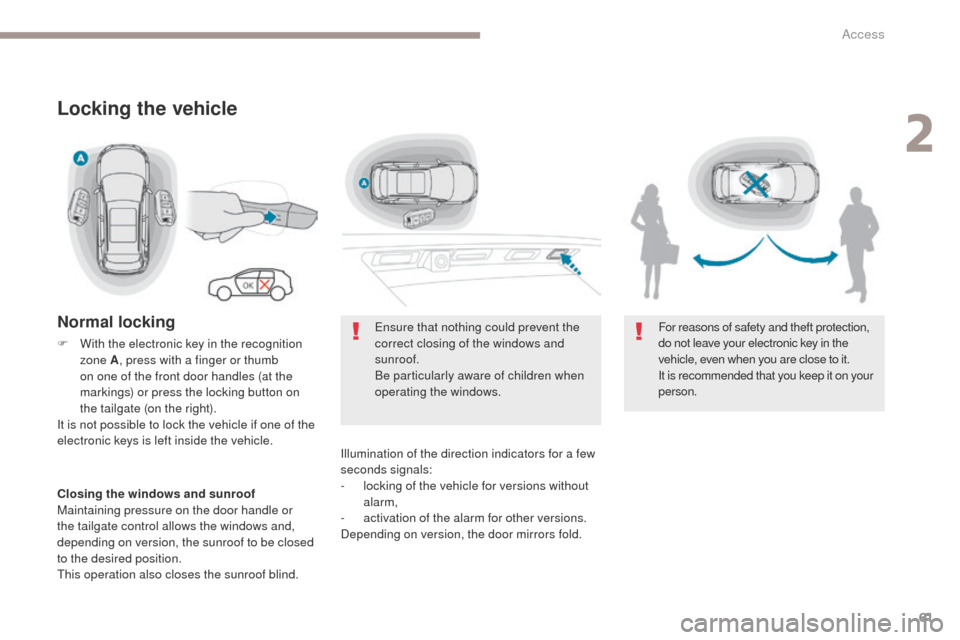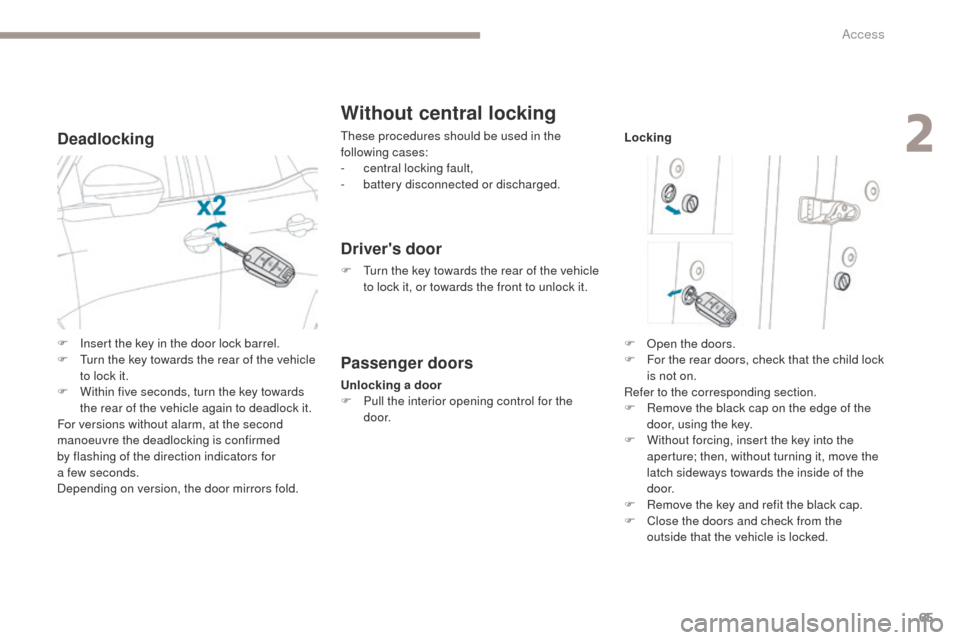2017 Peugeot 3008 Hybrid 4 child lock
[x] Cancel search: child lockPage 4 of 566

.
.
3008-2_en_Chap00a_sommaire_ed01-2016
Digital instrument panel 12
Indicator and warning lamps 1 6
Indicators
32
Manual test
4
0
Distance recorders
4
1
Lighting dimmer
4
2
Trip computer
4
3
Monochrome screen C
4
5
Touch screen
4
8
Remote control
5
4
Keyless Entry and Starting
5
8
Back-up procedures
6
4
Central locking
6
8
Alarm
70
D o o r s
74
Boot
7
5
Hands-free tailgate
7
6
Electric windows
8
2
Panoramic opening sunroof
8
4Driving position
8
8
Front seats
9
0
Steering wheel adjustment
9
9
Mirrors 99
i- Cockpit Amplify function
1
02
Heating and Ventilation
1
04
Manual air conditioning
1
06
Semi-automatic mono-zone air conditioning
1
08
Dual-zone automatic air conditioning 1 11
Front demist - defrost 1 16
Heated windscreen
1
17
Rear screen demist - defrost
1
18
Front fittings
1
19
Courtesy lamps
1
28
Interior mood lighting
1
29
Rear seats
1
30
Rear fittings
1
33
Boot fittings
1
35
Boot lamp
1
40Exterior lighting control stalk
1
41
Direction indicators
1
44
Headlamp beam height adjustment
1
45
Automatic illumination of headlamps
1
46
Automatic headlamp dipping
1
49
Cornering lighting
1
51
Wiper control stalk
1
52
Automatic rain sensitive wipers
1
55
General safety recommendations
1
56
Hazard warning lamps
1
57
Hor n
15
7
Emergency or assistance
1
58
Electronic stability programme (ESC)
1
60
Advanced Grip Control
1
64
Hill Assist Descent Control
1
66
Seat belts
1
68
Airbags
1
72
Child seats
1
77
Deactivating the passenger's front airbag
1
79
ISOFIX child seats
1
86
i-Size child seats
1
90
Child lock
1
93
Over view
Eco-driving
Instruments
Access Ease of use and comfort
Lighting and visibility
Safety
Contents
Page 7 of 566

5
3008-2_en_Chap00b_vue-ensemble_ed01-2016
Roof bars 293
Panoramic opening sunroof 8 4- 87
Under-inflation detection
2
23-225
Tyre pressures
2
23, 315, 345
Snow chains
2
92
Visiopark 1 & 2
2
65 -271
Rear parking sensors
2
63-264 Child lock
19
3 -19 4
Towing
336-337
Towbar
1
96, 284
Quickly detachable towball
2
85 -289
Trailer stability assist
1
63Fuel tank
28
1-283
Misfuel prevention
2
82
AdBlue tank
3
03 -306
Door mirrors
9
9 -100
Guide-me-home / welcome lighting
14
6 -148
Blind Spot Monitoring System
26
0-262
Changing rear bulbs
3
28-330
Defrosting the rear screen
1
18
Rear wiper
15
3 -15 4
Boot
5
7, 59, 75
Hands-free tailgate access
7
6 - 81
Tools
309-311
Temporary puncture repair kit
3
12-316
Spare wheel
3
17-322
Exterieur
.
Over view
Page 10 of 566

8
3008-2_en_Chap00b_vue-ensemble_ed01-2016
Multifunction steering wheel
Memorising speeds 226
Speed limit recognition 2 27-230
Speed limiter
23
1-233
Cruise control
23
4-237
Dynamic cruise control with Stop function
23
8-246
Adjusting the steering wheel
9
9 Wiper c ontrols
15
2-155
Trip computer 4 3 - 44
Dynamic Pack 2 17
Lighting c ontrols
14
1-14 4, 146 -15 0
Alarm volumetric and anti-tilt monitoring
70-73
Heated windscreen
1
17
Electric child lock
1
94
Hor n
157
Adjusting the headlamp beam height
1
45
Unlocking - Opening / Closing the hands-free tailgate
7
6 - 81
Stop & Start
2
19 -222
Side switch panel
Instruments and controls
Over view
Page 56 of 566

54
3008-2_en_Chap02_ouvertures_ed01-2016
Remote control
The remote control can be used for the
following functions, depending on version:
-
u
nlocking / locking / deadlocking the
vehicle,
-
u
nlocking and opening the boot,
-
s
witch on the lighting from a distance,
-
f
olding / unfolding the door mirrors,
-
a
ctivation / deactivation of the alarm,
-
o
pening the windows,
-
c
losing the windows and the opening roof,
-
l
ocating the vehicle,
-
v
ehicle immobiliser.
In normal operating conditions, it is preferable
to use the remote control.
General points
The key, integral with the remote control, can
be used for the following functions, depending
on version:
-
u
nlocking / locking / deadlocking the
vehicle,
-
t
urning the child lock on or off,
-
a
ctivation / deactivation of the passenger's
front airbag,
-
b
ack-up door locking,
-
s
witching on the ignition and starting /
stopping the engine.
Ejecting the key
Version with Keyless Entr y and Star ting
F P ull on this button to remove the key from
the housing.
To return it to the housing, first pull on this
button. Version without Keyless Entr y and Star ting
F
P
ress this button; the key is ejected from its
housing.
To avoid damaging the mechanism, first press
this button to fold it.
Back-up procedures allow the vehicle to be
locked or unlocked in the event of a failure
of the remote control, the central locking,
the
batter y...
For more information on the Back-up
procedures , refer to the corresponding
section.
Access
Page 62 of 566

60
3008-2_en_Chap02_ouvertures_ed01-2016
If one of the doors or the boot is still
open or if the electronic key for the
Keyless Entry and Starting system has
been left inside the vehicle, the central
locking does not take place.
However, the alarm (if fitted) will be fully
activated after about 45 seconds.As a safety measure (children on
board), never leave the vehicle without
taking the electronic key for the Keyless
Entry and Starting system with you,
even for a short period.
Be aware of the risk of theft when the
electronic key for the Keyless Entry and
Starting system is in one of the defined
zones with the vehicle unlocked.
The automatic folding and unfolding
of the door mirrors can be deactivated
by a PEUGEOT dealer or a qualified
workshop. In order to preserve the battery in the
electronic key and the vehicle's battery,
the "hands-free" functions are put into
long-term standby after 21 days without
use. To restore these functions, press
one of the remote control buttons or
start the engine with the electronic key
in the reader.
For more information on starting with
Keyless Entr y and Star ting
, refer to
the corresponding section.
If the vehicle is unlocked by mistake
and with no action on the doors or boot,
the vehicle will lock again automatically
after about 30 seconds.
If fitted to your vehicle, the alarm will
also be reactivated automatically.
Access
Page 63 of 566

61
3008-2_en_Chap02_ouvertures_ed01-2016
Ensure that nothing could prevent the
correct closing of the windows and
sunroof.
Be particularly aware of children when
operating the windows.
Illumination of the direction indicators for a few
seconds signals:
-
l
ocking of the vehicle for versions without
alarm,
-
a
ctivation of the alarm for other versions.
Depending on version, the door mirrors fold. For reasons of safety and theft protection,
do not leave your electronic key in the
vehicle, even when you are close to it.
It is recommended that you keep it on your
person.
Locking the vehicle
Normal locking
F With the electronic key in the recognition
zone A , press with a finger or thumb
on one of the front door handles (at the
markings) or press the locking button on
the tailgate (on the right).
It is not possible to lock the vehicle if one of the
electronic keys is left inside the vehicle.
Closing the windows and sunroof
Maintaining pressure on the door handle or
the tailgate control allows the windows and,
depending on version, the sunroof to be closed
to the desired position.
This operation also closes the sunroof blind.
2
Access
Page 65 of 566

63
3008-2_en_Chap02_ouvertures_ed01-2016
Remote control
The high frequency remote control is a sensitive system; do not operate it while it is in your pocket as there is a possibility that it may unlock the
vehicle, without you being aware of it.
Do not repeatedly press the buttons of your remote control out of range and out of sight of your vehicle. You run the risk of stopping it from
working and the remote control would have to be reinitialised.
The remote control does not operate when the key is in the ignition, even when the ignition is switched off.
Locking the vehicle
Driving with the doors locked may make access to the passenger compartment by the emergency services more difficult in an emergency.
As a safety precaution (with children on board), remove the key from the ignition or take the electronic key when you leave the vehicle, even for
a short time.
Electrical interference
The Keyless Entry and Starting electronic key may not operate if close to certain electronic devices: telephone, laptop computer, strong
magnetic fields, ...
Anti-theft protection
Do not make any modifications to the electronic engine immobiliser system; this could cause malfunctions.
For vehicles with an ignition switch, do not forget to remove the key and turn the steering to engage the steering lock.
Lost keys, remote control, electronic key
Visit a PEUGEOT dealer with the vehicle's registration certificate, your personal identification documents and if possible, the label bearing the
key code.
The PEUGEOT dealer will be able to retrieve the key code and the transponder code required to order a new key.
Do not throw the remote control batteries away, they contain metals which are harmful to the environment.
Take them to an approved collection point.
When purchasing a second-hand vehicle
Have the key codes memorised by a PEUGEOT dealer, to ensure that the keys in your possession are the only ones which can start the vehicle.
2
Access
Page 67 of 566

65
3008-2_en_Chap02_ouvertures_ed01-2016
Deadlocking
Without central locking
These procedures should be used in the
following cases:
-
c
entral locking fault,
-
b
attery disconnected or discharged.
Driver's door
F Turn the key towards the rear of the vehicle to lock it, or towards the front to unlock it.
Passenger doors
Unlocking a door
F P ull the interior opening control for the
d o o r. Locking
F
O
pen the doors.
F
F
or the rear doors, check that the child lock
is not on.
Refer to the corresponding section.
F
R
emove the black cap on the edge of the
door, using the key.
F
W
ithout forcing, insert the key into the
aperture; then, without turning it, move the
latch sideways towards the inside of the
d o o r.
F
R
emove the key and refit the black cap.
F
C
lose the doors and check from the
outside that the vehicle is locked.
F
I
nsert the key in the door lock barrel.
F
T
urn the key towards the rear of the vehicle
to lock it.
F
W
ithin five seconds, turn the key towards
the rear of the vehicle again to deadlock it.
For versions without alarm, at the second
manoeuvre the deadlocking is confirmed
by
flashing of the direction indicators for
a few seconds.
Depending on version, the door mirrors fold.
2
Access